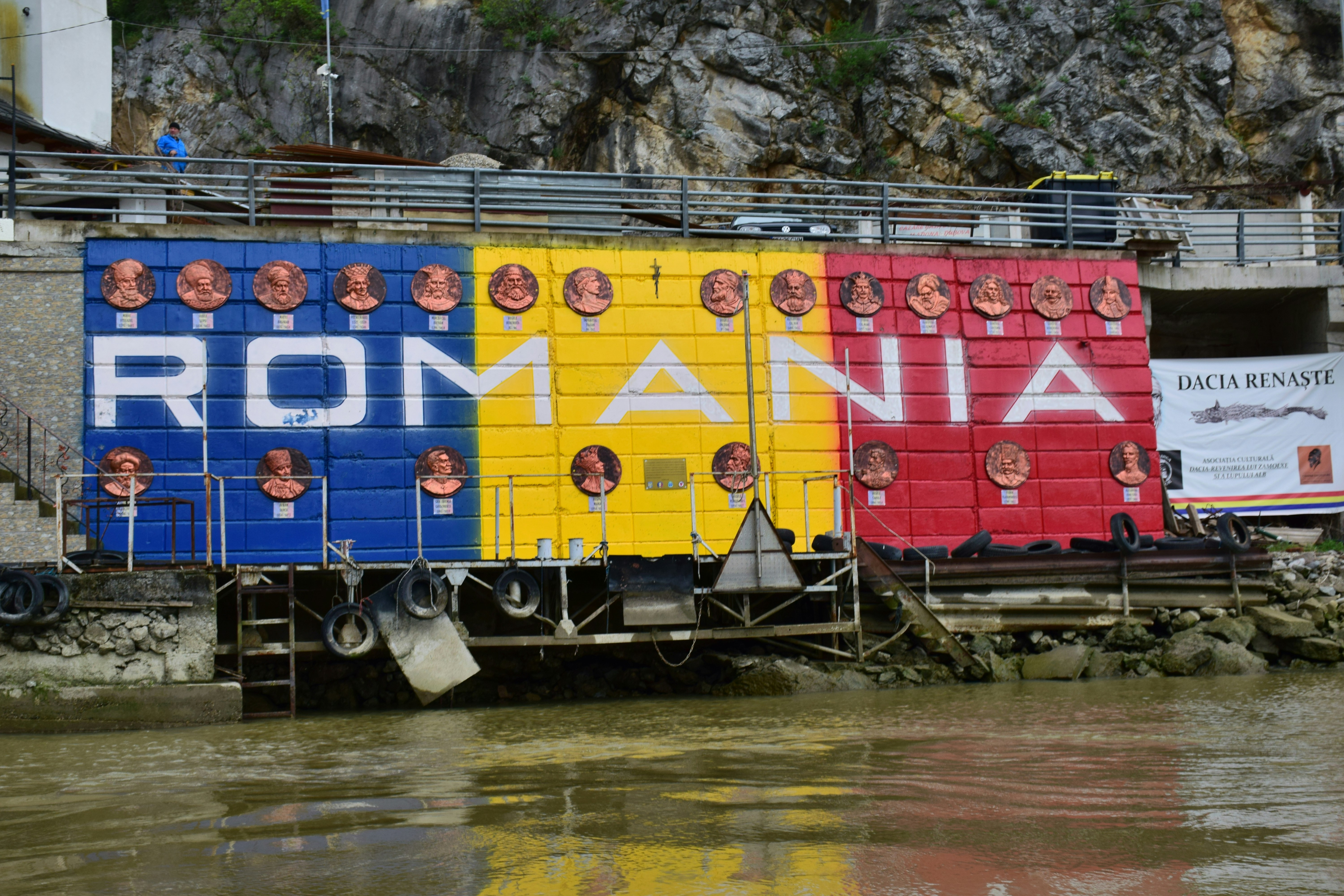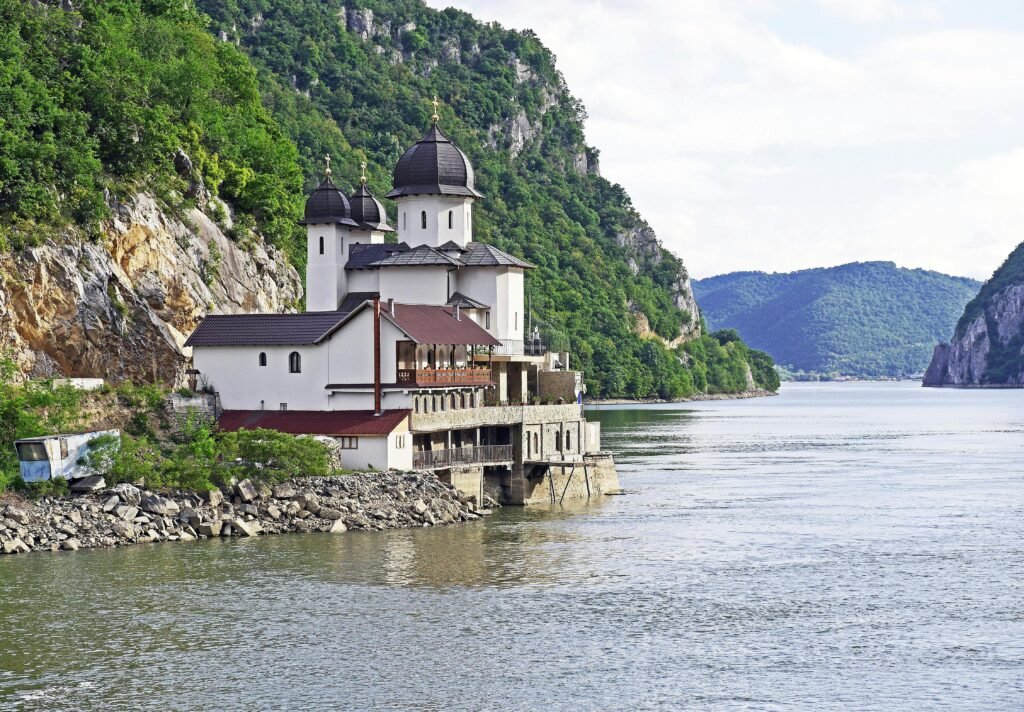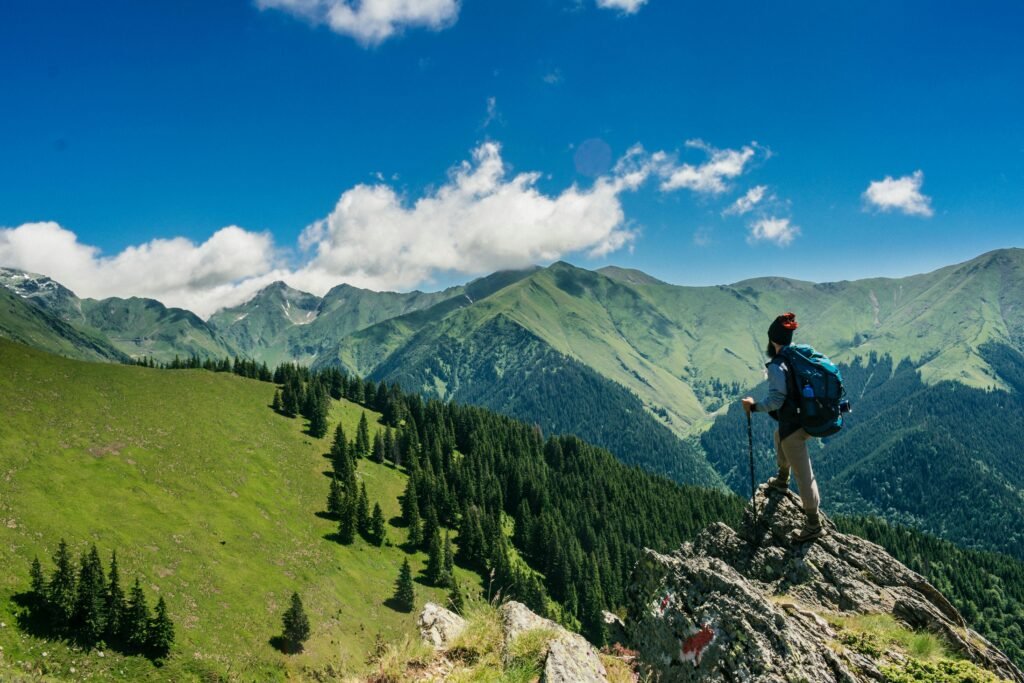Overview of Romania’s Diverse Landscapes
Romania is renowned for its striking landscapes and diverse geographical features, presenting an impressive array of natural beauty that captivates visitors. The Carpathian Mountains serve as a central spine for the country, stretching in a semi-circle from the north to the south. This majestic mountain range is not only a haven for outdoor enthusiasts, offering opportunities for hiking, skiing, and mountain biking, but it is also home to rich biodiversity, including species such as brown bears, wolves, and lynxes. The Carpathians’ dramatic peaks and pristine forests provide a picturesque backdrop that showcases Romania’s natural allure.
In addition to the mountains, the Danube River graces Romania with its tranquil presence. As one of Europe’s major rivers, the Danube traverses the southern part of the country, creating a natural boundary with neighboring countries. Its breadth offers opportunities for various recreational activities, including boating, fishing, and birdwatching. The river also flows into the Danube Delta, a UNESCO World Heritage site, where the interplay of water and land supports an impressive array of flora and fauna. This wetland is particularly significant for migratory birds, making it an important ecological zone.

The coastline along the Black Sea is yet another highlight of Romania’s geography. Stretching from the city of Constanta to the border with Bulgaria, the Black Sea coast is known for its sandy beaches, vibrant resorts, and rich cultural history. This region not only attracts tourists seeking sun and relaxation but also provides opportunities to explore ancient ruins and seaside towns that reflect the unique cultural heritage of Romania. The convergence of mountains, rivers, and coastlines creates a rich tapestry of landscapes that contributes to Romania’s reputation as a destination of natural beauty and adventure.
Historical and Cultural Attractions
Romania is a treasure trove of historical and cultural attractions that beckon travelers to explore its rich heritage. Among the most iconic landmarks are Bran Castle and Peleș Castle, both of which exemplify the country’s architectural splendor and storied past. Bran Castle, often associated with the Dracula legend, is a medieval fortress nestled in the Carpathian Mountains. Its imposing structure and intriguing history draw visitors eager to uncover the myths and realities surrounding Count Dracula. The castle’s exhibits, featuring artifacts from Romanian history, provide a captivating insight into the region’s past.
Peleș Castle, located in Sinaia, is another remarkable example of Romania’s historical architecture. Constructed in the late 19th century, this Neo-Renaissance masterpiece served as the summer residence for the Romanian royal family. Its opulent interiors, lush gardens, and breathtaking mountain backdrop make it a must-see destination. Tourists can stroll through its grand halls adorned with exquisite art and furnishings, allowing them a glimpse into the luxurious lifestyle of Romania’s monarchs.
In addition to these famous castles, Romania is home to numerous fortified churches that reflect its unique cultural heritage. These architectural marvels, built between the 14th and 16th centuries, were designed to serve as places of worship and refuges during times of conflict. The fortified churches of Transylvania, such as those in Biertan and Viscri, are recognized as UNESCO World Heritage sites. They stand as a testament to the resilience and creativity of the local populations, showcasing detailed frescoes and intricate woodworks.
Exploring Romania’s historical and cultural attractions offers more than just visual beauty; it invites visitors to engage with the stories and traditions that have shaped the nation’s identity. Each landmark narrates a chapter of Romania’s rich tapestry, encouraging travelers to appreciate the intricate blend of history and culture that defines this enchanting country.

Exploring Romanian Cities: Bucharest, Cluj-Napoca, and Sibiu
Romania is a country characterized by its diverse culture and rich history, with cities that showcase a blend of modern vibrancy and historical charm. Among its many cities, Bucharest, Cluj-Napoca, and Sibiu stand out as must-visit destinations, each offering a unique experience to travelers.
Bucharest, the capital city, is well-known for its vibrant nightlife and eclectic urban landscape. It features a mix of architectural styles, ranging from the historical charm of the old town to the modernity of contemporary structures. Visitors are invited to explore the lively streets filled with cafes, bars, and restaurants where traditional Romanian dishes can be savored. Noteworthy events, such as the George Enescu Festival, draw art lovers from around the world, creating a dynamic cultural atmosphere that highlights the city’s artistic flair.
In contrast, Cluj-Napoca serves as the cultural hub of Transylvania, renowned for its thriving arts scene and youthful energy. As home to Romania’s largest university, the city boasts a vibrant student population that contributes to its lively ambiance. Art galleries, theaters, and music festivals, such as the Untold Festival, flourish in Cluj-Napoca, making it a haven for creatives and visitors alike. The collaboration between various artistic communities fosters a unique fusion of contemporary and traditional Romanian culture.
Lastly, Sibiu captivates with its preserved medieval architecture and quaint atmosphere. Recognized as a European Capital of Culture in 2007, this picturesque city offers a glimpse into Romania’s history through its well-maintained squares and stunning buildings. Events like the Sibiu International Theatre Festival attract visitors keen on experiencing local traditions and performing arts. The city’s unique charm lies within its cobbled streets, vibrant murals, and friendly locals, providing an inviting experience for all who visit.
Outdoor Activities and Adventure Sports
Romania is a paradise for outdoor enthusiasts, offering a plethora of activities that cater to a variety of interests and skill levels. The Carpathian Mountains, which stretch across the heart of the country, are among the prime spots for hiking, with trails that range from easy walks to challenging climbs. Popular destinations such as the Bucegi National Park and Retezat National Park provide breathtaking landscapes, rich biodiversity, and well-marked trails, making them ideal for both seasoned hikers and beginners. The stunning views, diverse flora and fauna, and the chance to witness wildlife in its natural habitat are just a few of the many benefits of exploring these mountainous regions.
For those who prefer winter sports, Romania’s Transylvanian region boasts several ski resorts, including Poiana Brașov and Azuga. These locations not only offer well-maintained slopes but also facilities for snowboarding, sleigh rides, and more. The picturesque snowy landscapes are an added incentive, attracting ski enthusiasts from various parts of Europe. Beyond skiing, winter in Romania opens up opportunities for activities such as snowshoeing and ice climbing, catering to adventurers seeking unique experiences in a beautiful setting.
Aside from mountains and snow, Romania’s natural reserves and national parks offer astonishing opportunities for exploration. The Danube Delta, a UNESCO World Heritage Site, is an ecological paradise for bird watchers and fishing aficionados alike, featuring a labyrinth of waterways, marshlands, and lush vegetation. Meanwhile, the rural countryside is equally captivating, allowing travelers to discover traditional villages, vineyards, and a slower pace of life. Biking and horseback riding are excellent ways to traverse these rustic landscapes, providing an authentic glimpse into Romania’s culture and natural beauty.
Culinary Delights: Experiencing Romanian Cuisine
Romanian cuisine reflects the country’s rich history and diverse cultural influences, making it a unique culinary experience for travelers. Typically based on fresh ingredients, traditional Romanian dishes often combine vegetables, meats, and spices to create hearty and flavorful meals. One of the signature dishes is mămăligă, a cornmeal porridge akin to Italian polenta, which is often served as a side dish or a main course. This versatile staple can be paired with various toppings such as sour cream, cheese, or sautéed mushrooms, highlighting its adaptability in Romanian cooking.
Another popular delicacy is sarmale, which consists of cabbage rolls stuffed with a mixture of minced meat and rice, slow-cooked in tomato sauce. These rolls are a traditional feature at family gatherings and festive occasions, symbolizing warmth and hospitality. Travellers can also indulge in cozonac, a sweet bread often filled with nuts or cocoa, typically enjoyed during holidays and celebrations. This dish showcases the Romanian knack for blending flavors and textures, offering a tasty insight into the nation’s culinary traditions.
To fully appreciate the breadth of Romanian cuisine, visit local food markets, such as the Obor Market in Bucharest or the Great Market Hall in Cluj-Napoca. These bustling hubs offer a wide array of fresh produce, cheeses, meats, and baked goods, allowing visitors to engage with local vendors and learn more about traditional ingredients. For an authentic dining experience, consider seeking out family-owned restaurants or traditional “taverna” establishments that emphasize homemade dishes and regional specialties. Combining the exploration of local food markets with culinary experiences can provide travelers with a deeper understanding of Romania’s cultural heritage through its gastronomy.
Folklore and Cultural Traditions
Romania boasts a rich tapestry of folklore and cultural traditions that contribute significantly to its national identity. The roots of these traditions can be traced back to ancient times, shaped by a blend of Dacian, Roman, Slavic, and Ottoman influences. Throughout the year, various festivals celebrate these cultural elements, reflecting both regional diversity and communal spirit. For visitors, these vibrant celebrations are an opportunity to experience Romania’s unique cultural heritage firsthand.
One of the most notable festivals is the “Mărțișor,” celebrated on March 1st, marking the arrival of spring. During this event, people exchange small tokens called “mărțișoare,” which symbolize health and prosperity. Each mărțișor is traditionally crafted with red and white threads, representing the duality of life. Besides Mărțișor, the “Sânziene” festival, which takes place during the summer solstice, is another significant cultural event. It includes rituals for fertility and prosperity, accompanied by folk dances and music that showcase Romania’s deep-rooted traditions.
The music and dance of Romania are equally pivotal to its folklore. Each region has distinct styles, instruments, and rhythms that enrich the cultural landscape. The “doina,” a traditional Romanian musical form, embodies deep emotion and narrative, often reflecting themes of love or sorrow. Folk dances, such as the “hora,” foster community bonds, inviting participation from all ages. These performances are commonly showcased during cultural festivals and local celebrations, illustrating a collective joy that transcends generations.
Overall, Romania’s cultural traditions and folklore are not merely artifacts of the past; they serve as living expressions of the Romanian spirit. Engaging with these customs during a visit to Romania enhances the travel experience, providing insights into the values and practices that shape national identity. The combination of music, dance, and time-honored festivities truly enriches the journey through this captivating country.

Best Times to Visit Romania
When planning a visit to Romania, understanding the climatic conditions and cultural events that characterize each season is crucial for maximizing the travel experience. Generally, the best times to explore Romania are during the spring (March to May) and the autumn (September to November). These periods offer pleasant weather, fewer crowds, and vibrant local events that enhance the travel experience.
Spring is a particularly lovely time to visit Romania as the country comes to life with blooming flowers and lush greenery. Mild temperatures, typically ranging from 10°C to 20°C (50°F to 68°F), create an ideal atmosphere for outdoor exploration. Local festivals, like the famous Tulip Festival in the city of Bucharest, make spring an excellent time to witness Romania’s rich cultural tapestry. Additionally, visiting during this season allows one to explore historic sites without the bustling tourist crowds, providing a more intimate experience.
Autumn is also a favorable time to experience Romania’s captivating landscapes and cultural heritage. With temperatures between 10°C and 25°C (50°F to 77°F), the fall foliage transforms the countryside into a picturesque setting. The traditional harvest festivals that abound during this season allow travelers to engage with local customs and cuisine, showcasing the country’s agricultural bounty. Key events, such as the Grapes and Wine Festival in the historic region of Transylvania, offer a unique opportunity to taste local wines and delve into regional traditions.
For those interested in winter sports and holiday festivities, visiting Romania between December and February is worthwhile. The Carpathian Mountains offer various winter activities, including skiing and snowboarding. However, it is advisable to prepare for colder temperatures and consider the holiday season when many attractions may be busier.
In conclusion, the best times to visit Romania depend on individual preferences for climate and activities. By aligning travel plans with these seasonal highlights, visitors can enrich their experience of Romania’s diverse culture and stunning natural beauty.
Understanding Local Customs and Etiquette
When traveling to Romania, understanding local customs and etiquette can enhance your experience and foster positive interactions with the locals. Greetings play a significant role in Romanian culture; a firm handshake is the most common way to greet someone, often accompanied by direct eye contact. Friends and family may also greet each other with kisses on both cheeks, which showcases the warmth and hospitality inherent in Romanian society. It is important to note that addressing individuals appropriately is vital; using titles followed by the person’s surname indicates respect.
Dining practices in Romania hold their own set of customs. When invited to a local home, it is customary to bring a small gift, such as flowers or sweets. Upon entering a house, guests may be asked to remove their shoes, a sign of hospitality and cleanliness. During meals, one should wait for the host to start eating before beginning their meal. It is also polite to finish everything on your plate, as leaving food can be interpreted as wasteful. Furthermore, Romanians typically express gratitude with the phrase “mulțumesc” and appreciate when visitors attempt to use their language, even if it is just a few words.
Public behavior is another significant aspect of Romanian etiquette. It is advisable to dress modestly, particularly when visiting churches or religious sites. Overall, personal space is respected in Romanian culture, and maintaining appropriate distance during conversations is expected. It is best to avoid sensitive topics such as politics or religion during initial meetings, focusing instead on lighter subjects to ease into conversations. By being aware of and adhering to these customs, travelers can ensure a respectful and enjoyable interaction with the rich culture and people of Romania.
Transportation Options for Exploring Romania
When planning a visit to Romania, understanding the various transportation options available is crucial for optimizing your travel experience. Romania boasts a diverse transportation network that caters to both urban and rural areas, making it accessible for travelers to explore its rich history, culture, and breathtaking natural beauty.
Public transport in Romania is well-developed, especially in larger cities. Urban centers such as Bucharest, Cluj-Napoca, and Timișoara feature expansive bus, tram, and metro systems. These forms of public transit offer an affordable and efficient way to navigate city destinations. Tickets can typically be purchased at kiosks or through mobile apps, providing a convenient option for travelers. For those venturing to smaller towns or rural regions, long-distance buses and trains are readily available. The national railway system, Căile Ferate Române (CFR), connects major cities and popular tourist destinations, allowing travelers to enjoy picturesque views from the comfort of the train.
For those seeking more flexibility, renting a car is an ideal option. Romania’s road infrastructure is reasonably good, and having a vehicle allows more freedom to explore off-the-beaten-path locations. International car rental companies operate in major airports and cities, and local agencies may offer competitive rates. It is important to be aware, however, of the driving regulations and road conditions, particularly in more remote areas.
Additionally, domestic flights can be a time-efficient alternative, especially when traveling between cities such as Bucharest, Cluj-Napoca, and Iași. Several airlines operate regional flights, allowing travelers to cover long distances in a shorter time frame. Whether opting for public transport, renting a vehicle, or choosing to fly, Romania provides a variety of transportation options designed to enhance your adventure. Each method carries its own advantages and can be chosen based on personal preferences, budget, and travel itinerary.



